Does this sound familiar from handling many ongoing projects in parallel: inefficient scheduling, employee overload, repeatedly increased costs or quality problems? If you consider the success factors for multi-project management described below, these pain points will decrease significantly. You will learn what leads to successful multi-project management or program management in the following chapters:
- Definition multi-project management
- Distinguishing between multi-project and program management
- Challenges in multi-project management
- Problems in multi-project management and their causes
- 7 crucial success factors for multi-project management
- The most important rules
- Checklist: Success factors for multi-project management
Definition Multi-Project Management
Multi-project management comprises all projects of an organizational unit – i.e. many projects are implemented in parallel and with the same resource pool.
Distinguishing between Multi-Project Management and Program Management
We define the distinction between multi-project management and program management as follows:
- Projects within a program serve a common, overall goal.
- Multi-Project management comprises all projects of an organizational unit
Interested in program management? Read 8 tips on how to succeed.
Challenges in Multi-Project Management
If you are working in a multi-project environment, you will be familiar with the number one challenge: you have to implement many projects in parallel while drawing on the same resource pool.
In addition, smooth functioning is hampered by the circumstances of the multi-project environment:
- Projects are implemented in different departments
- Resources from different departments need to be coordinated
- The projects’ priority and strategic contribution can change
- Project costs have to correspond to the budget
- Some projects are interdependent
- The project environment becomes more and more international
- Report requirements become increasingly complex
- Decisions have to be made in a short space of time
- Precise project information is required
Problems in Multi-Project Management and Their Causes
It is a fact that: the sheer number of parallel projects makes for regular surprises. This leads to the problems listed at the beginning:
- Rescheduling
- Resource conflicts
- Cost increases
- Variations in quality
The reasons for these problems vary:
- Missing overview of all projects and resources
- Wrong priorities for initiatives and projects
- Unrealistic planning of delivery dates and efforts
- Unprofessional management of the projects
- Wrong decisions in the case of resource conflicts
- Improper closure and documentation of projects
If you succeed in reducing these problems, or even removing them as far as possible, your projects will be more successful.
Subscribe to the TPG Blog Newsletter now and never miss another blog post.
The following 7 success factors will help you.
Read this article and find out more about the meaning of project success.
7 Crucial Success Factors for Multi-Project Management
Success Factor 1: Provide for an Overview
Keep track of the many parallel projects. You will only succeed in this if you use a central database once you have reached a certain number of projects. The central database will permit you to produce reports as required for your information or for informed decisions.
The chart below shows the different possible perspectives on the project portfolio. In addition to a central project list and resource overview, the illustration provides the following information on the portfolio:
- Status reports
- Portfolio and pipeline overviews
- Risk matrix
- Resource and cost charts
Learn more about the Project Status Report, its Contents and the Process Involved.
Underneath, you can find the tools for controlling the individual projects: for resource coordination, project monitoring, and data exchange with the controlling department.
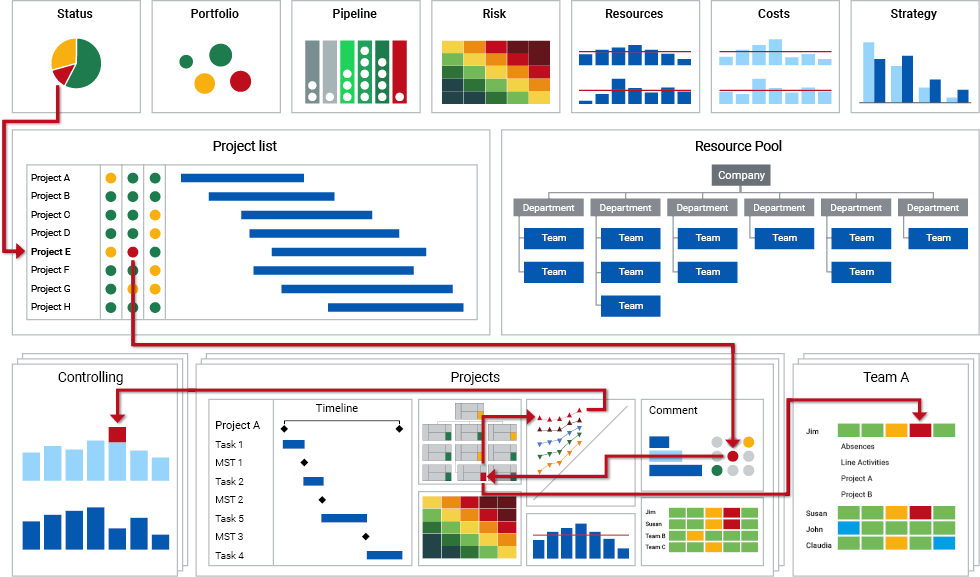
Read more about:
- 3 Avenues to Introduce a Project Portfolio Management System
- 5 Arguments to Win Over Decision-Makers for Project Portfolio Management
With a central solution such as The PPM Paradise, you can track all information from the aggregated overview down to the smallest detail. If you are looking to implement an environment of this kind, remember this: better to start with limited functionality and build on that than to use maximum functionality and fail at the very beginning.
Our tip: Make portfolio meetings time-limited. It is impossible to look at all projects and resources each time. Therefore, make sure that you define traffic light indicators and other criteria that will allow you to effectively filter the right projects and resources.
Success Factor 2: Employ Your PMO
If you want to administer your multi-project environment efficiently, your projects have to meet certain standards in structure and setup. In addition, you need to define processes for planning and updating projects.
As decisions have cross-project effects, controlling for all projects should follow the same intervals – using data that is as recent as possible. Project managers need to know what to do when. And how to do it. That is why they need the appropriate training and supervision.
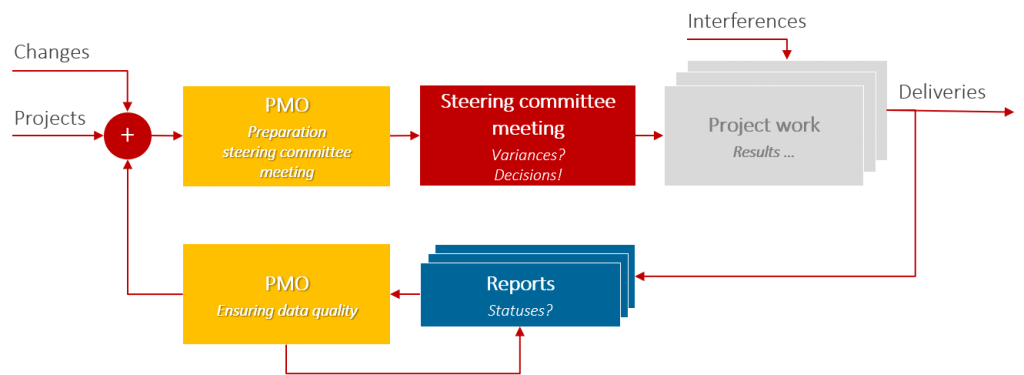
The latter can be responsibilities of a PMO serving as a hub of communication between project managers, team leaders, decision-makers, and controllers.
Your PMO should be responsible for the efficient flow of information and the continuous improvement of the maturity level in project management. For instance, improvements could include:
- Supporting the roles involved
- Determining how projects are initiated
- Coordinating resource requests
- Ensuring reports are up to date, complete and plausible
- Establishing processes and methods
- Training project managers
- Introducing a suitable tool for project, portfolio and resource management
The benefits of a well-established and accepted PMO should be:
- Time savings due to routine and training
- Decrease in project delays, costs and effort overruns
- Improved profitability of customer projects
- Reduction of resource conflicts
- Improved strategic direction of the projects
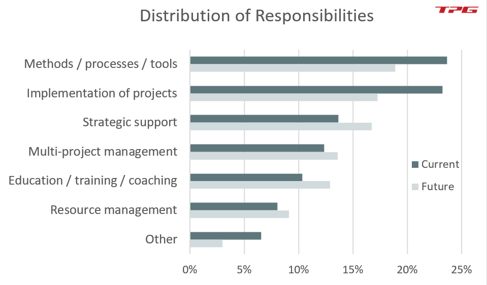
Our tip: It is vital for your PMO to have backing from top management. However, it must not be perceived as a supervisory body. Instead, it has to give clear proof of its value to the project teams. This will ensure acceptance.
Success Factor 3: Prioritize Initiatives and Projects Appropriately
To avoid having to deal with too many projects at once, you should concentrate on the important and urgent ones. Therefore, set priorities in line with corporate strategy. Start your projects according to these priorities.
We urgently recommend a way of making prioritization easier. Create a decision matrix to differentiate between operations and different project types. The design of this project-worthiness analysis needs to be individual for every company.
| Number of areas involved | 1 area | Up to 3 areas | Over 3 areas | Up to 3 areas |
| Size of entire project team | 2 – 5 people | Over 6 people | Over 12 people | Over 6 people |
| Resource requirements | 10 – 30 man-days | 30 – 100 man-days | Over 100 man-days | 30 – 100 man-days |
| Capital expenditure | Under 10.000 € | 10.000 – 50.000 € | Over 50.000 € | 10.000 – 50.000 € |
| Duration | 1 – 3 months | 4 – 10 months | Over 10 months | 4 – 10 months |
| Inherent complexity | Low | Medium | High | High |
| Novelty for project team | Low | Medium | High | Low |
| Quality Risk | Low | Medium | High | Medium |
| External effect | Low | Medium | High | Low |
Project-worthiness analysis for distinguishing between operations and project types
Depending on the rating, you need to use different controlling methods. This is about expending administration and controlling effort appropriate to the size of the undertaking.
Make your prioritization independent of the project type. You can determine the importance using previously established drivers.
Our tip: Make sure you actually use the most resources for the most important projects.
Read about 7 steps to optimal project portfolio management.
Success Factor 4: Be Strategic in Your Capacity Planning
Strategic resource planning, also known as capacity planning, has one aim: the predictive allocation of employees with the necessary skills.
You also need to ensure that the appropriate employees will be available at the right time to implement strategically relevant projects.
With inadequate capacity planning you run risks such as:
- Projects are not finished on time due to insufficient resource allocation
- Project costs increase, as you are not using enough appropriate resources
- Business opportunities cannot be exploited, as the required skills could not be obtained on time
- Your coordination efforts for resolving resource conflicts are significantly higher
- All of this can result in dissatisfied customers
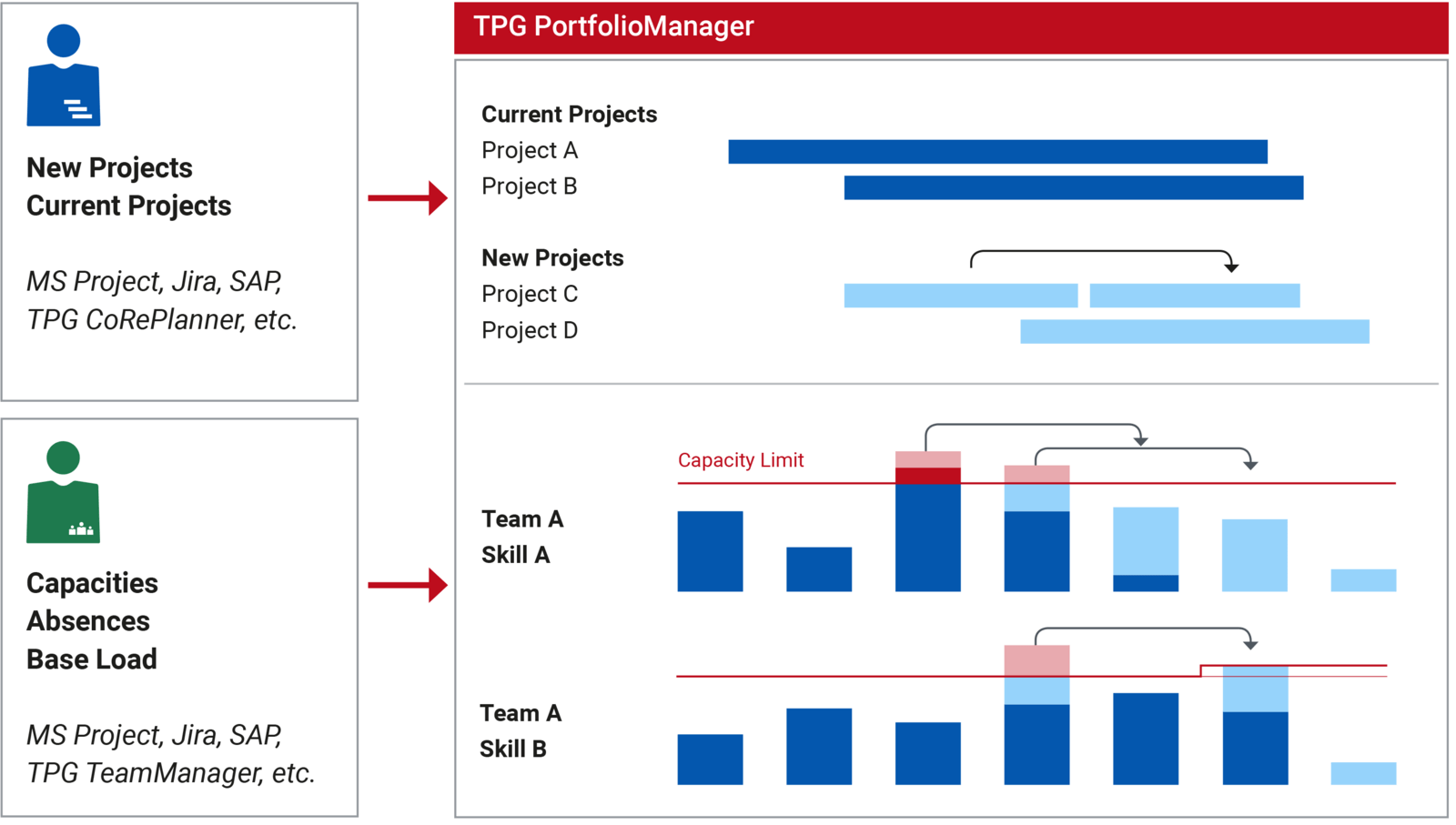
Strategic resource planning done properly can gain you a variety of benefits.
These include for instance:
- You ensure that you reserve the most resources for the most important projects rather than for staffing unimportant ones
- A complete overview of all resources, their project assignments and operations will keep you informed about the overall resource utilization
- You know which – and how many – new projects can be started and also carried out in addition
- You recognize resource bottlenecks in good time and are able to react to them in accordance with your corporate strategy
- Many resource conflicts are avoided, as they never actually arise
Our tip: For successful strategic capacity planning, a strong PMO with backing from top management is vital. In addition, you need a suitable tool environment corresponding to the number of projects and resources.
Read more about the success factors of capacity planning.
Watch this related video: Ad-hoc Optimization of Resource Utilization in a Microsoft Project Portfolio (TPG PortfolioManager)
Success Factor 5: Optimally Support Tactical Resource Planning
Tactical resource planning is the process of coordination between project manager and team leader. Project managers assign resources to the tasks of their projects. In doing so, they hope to actually get the team members they planned with. Where the resources they planned with are deployed in the end, is the decision of the respective team leaders.
Resource planning is anything but easy for project managers and team leaders because:
- Efforts may not have been estimated as required
- Team members are not as interchangeable as initially assumed
- Project scope and delivery dates can change
- Absences due to illness tend to be unexpected
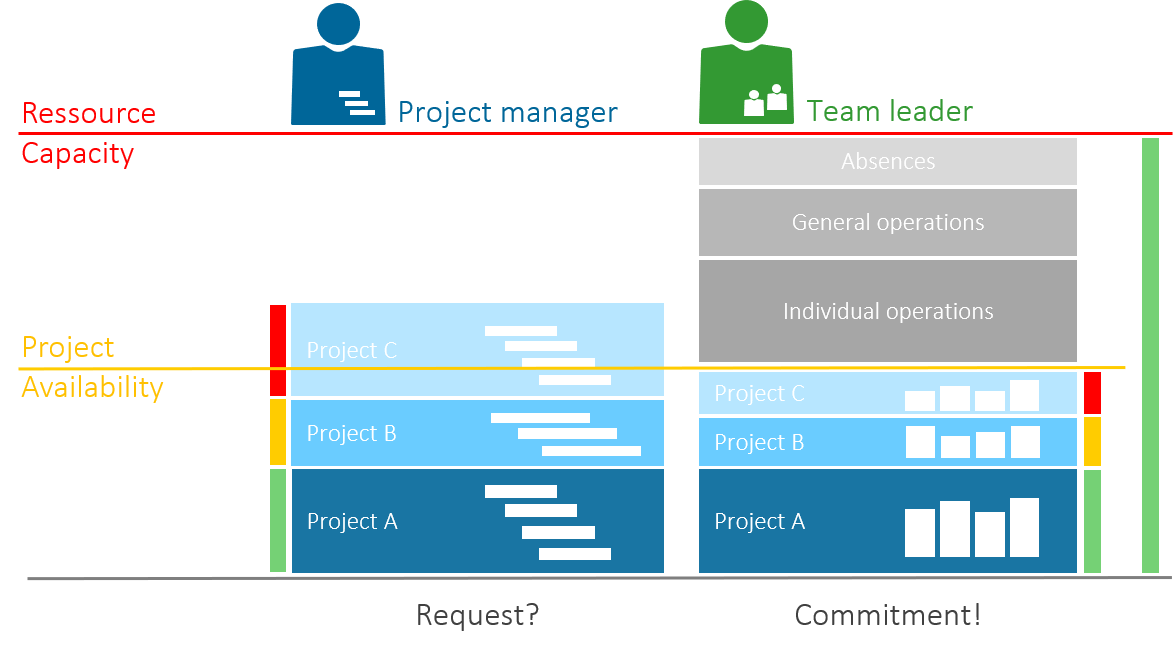
A general rule for resource planning is: only complete planning is good planning. To achieve this, you should mark the following points:
- Planning can be considered complete once each team member’s absences, operations and project assignments have been recorded
- Only team leaders are able to plan completely for their team members; project managers lack this insight
- Project availability is determined by looking at the capacity minus absences and operations
- Planning project assignments differs between line and matrix organizations.
Our tip: Better to be complete and slightly unspecific in your planning than specific but incomplete. Only complete planning is good planning. And get used to the idea that resource planning will not always be 100 per cent specific. Outside interferences tend to come before you can adjust your planning.
You might like our article about Implementing Project Resource Management or consider getting our free eBook on tactical resource planning below.
Success Factor 6: Ensure Transparency of Dependencies
The steering committee for multi-project management or programs issues its targets at regular intervals. This includes, for instance, directives concerning the important milestones at the interfaces.
These targets are allocated to the corresponding projects (top-down). And the project managers have to implement them.
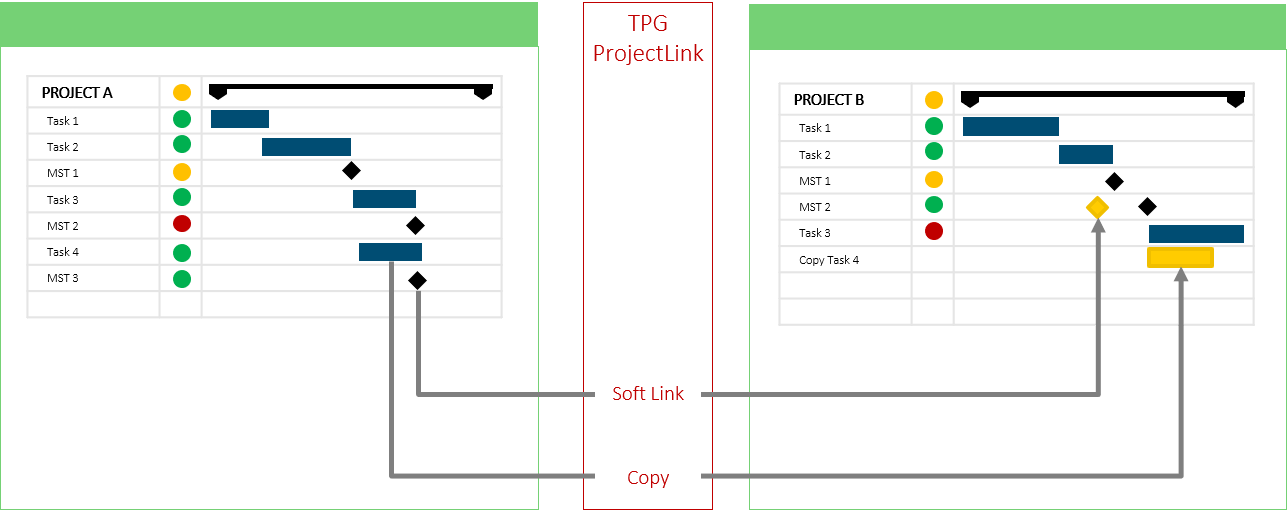
Our tip: Use “soft” links between the tasks of different projects. These have the advantage that project managers can see the resulting scheduling conflicts directly when making changes. However, this happens without changing their own plan, which is important. After all, project managers stay in control of their own planning.
Success Factor 7: Simplify Budget Planning and Cost Tracking
In performing their tasks, project managers and controllers are reliant on each other’s data.
This makes it necessary to provide for system integration between both worlds. Without an automatic transfer of data in both directions, two things would be impossible:
- Timely monthly billing
- Prompt distribution of remaining budgets between the projects
The basic integration scenarios are the following:
- Aligning the project structure of the PPM and ERP systems
- Forecast transfer from the PPM system to the ERP system for budget creation
- Transferring the actual hours from the PPM system to the ERP system for settlement
- Transferring the actual cost from the ERP to the PPM system for controlling
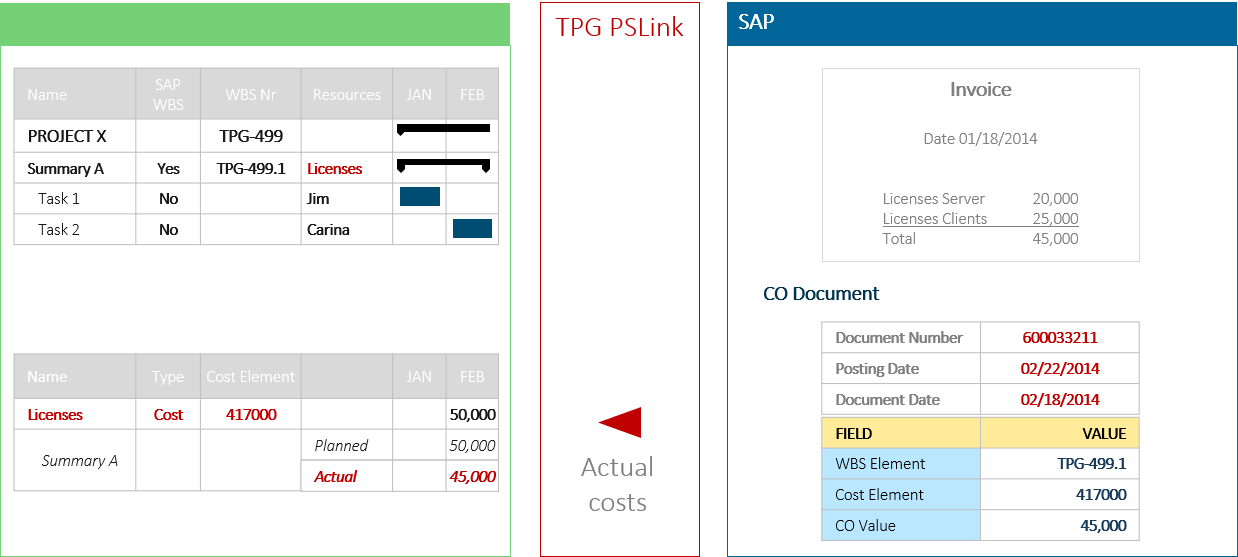
The advantages of such an integration are as follows:
- No dual data entry
- Timely provision of data
- High data quality
Our tip: The benefit of such an integration increases along with the number of projects and updates. An integration of PPM, ERP and other systems can be simple at first. It can be gradually extended as required.
Summing Up the Most Important Rules
- Better to make your planning complete and rough than incomplete and too detailed
- The biggest mistakes arise if you do not plan all projects and resources
- It is better to start with limited functionality and build on that than to use maximum functionality and fail at the very beginning
This way to further information on the subject:
The optimum environment for multi-project management – The PPM Paradise
Success Factors for Multi-Project Management: Checklist
This article has explained why multi-project management ranks among the more difficult disciplines. And why this can have consequences for everyday project management.
You have also learned about 7 success factors for multi-project management which could help you master the challenges of multi-project environments:
- Success factor 1: Stay on top of many parallel projects with central project lists, reports, and overviews.
- Success factor 2: Use your PMO for standards, processes and methods to increase project success.
- Success factor 3: Prioritize initiatives and projects according to importance and urgency and in line with your corporate strategy.
- Success factor 4: Plan your capacities strategically. And make sure strategically relevant projects are implemented by qualified employees.
- Success factor 5: Support tactical resource planning with complete planning by the team leaders.
- Success factor 6: Ensure transparency (top-down and bottom-up) in the case of cross-project dependencies through “soft” links between tasks and different projects.
- Success factor 7: Simplify cross-project budget planning and cost tracking by integrating the controlling and PPM systems.
How do you master the challenges of multi-project management? Do you feel we have missed an essential point? We look forward to receiving your comments.
About the author: Johann Strasser, a certified engineer, has been a managing partner at TPG The Project Group since 2001. After many years as a development engineer in the automotive and energy sectors, Johann Strasser spent a decade as an independent trainer and consultant in the field of project management. During his tenure, he also served as project manager for software projects in the construction industry and provided scheduling and cost management support for large-scale construction projects. At TPG, he applies his expertise in product development and consulting services for international clients. His special focus is on PMO, project portfolios, hybrid project management, and resource management. For many years now, he has shared his knowledge through presentations, seminars, articles, and webinars.
You can read more about Johann Strasser on LinkedIn and XING.







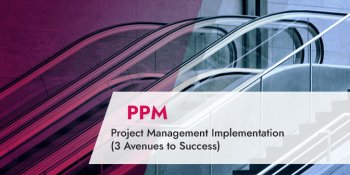
2 Comments
buen articulo, sin embargo no esta claro que herramientas usar para cumplir cada uno de los pasos.
Good article, however it is not clear what tools to use to comply with each of the steps.
Hello Mr. Gualdron,
in this article we refer to a couple of different products to accomplish the suggested steps.
All Tools address different roles in the project management process:
For integration purposes (for automated data exchange), you can use our interface tool TPG PSLink (adresses Controlling)
For cross-project linking, we suggest TPG ProjectLink (adresses Project- and Program Managers)
For operational resource management, there is the resource planning tool TPG TeamManager (adresses Line Managers)
For strategic resource management, you can work with